Molar absorptivity - Study guides, Class notes & Summaries
Looking for the best study guides, study notes and summaries about Molar absorptivity? On this page you'll find 60 study documents about Molar absorptivity.
All 60 results
Sort by
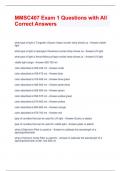 Popular
Popular
-
MMSC407 Exam 1 Questions with All Correct Answers
- Exam (elaborations) • 9 pages • 2024
- Available in package deal
-
- $12.99
- 1x sold
- + learn more
MMSC407 Exam 1 Questions with All Correct Answers what type of light a Tungsden (Quartz-Vapor) exciter lamp shows us - Answer-visible light what type of light a Hydrogen/ Deuterium exciter lamp shows us - Answer-UV light what type of light a Xenon/MercuryVapor exciter lamp shows us - Answer-UV light visible light range - Answer-350-700 nm color absorbed at 350-430 nm - Answer-violet color absorbed at 430-475 nm - Answer-blue color absorbed at 475-495 nm - Answer-blue-green color abso...
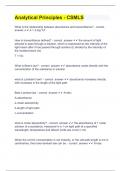
-
Analytical Principles Question and answers 100% correct
- Exam (elaborations) • 15 pages • 2024
-
- $14.49
- + learn more
Analytical Principles Question and answers 100% correct Analytical Principles - CSMLS What is the relationship between absorbance and transmittance? - correct answer A = 2-log %T How is transmittance defined? - correct answer the amount of light allowed to pass through a solution, which is expressed as the intensity of the light beam after it has passed through solution (I) divided by the intensity of the incident beam (Io) T = I/Io What is Beer's law? - correct answer absorbanc...
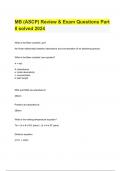
-
MB (ASCP) Review & Exam Questions Part II solved 2024
- Exam (elaborations) • 26 pages • 2024
-
- $7.99
- + learn more
MB (ASCP) Review & Exam Questions Part II solved 2024 What is the Beer-Lambert Law? the linear relationship between absorbance and concentration of an absorbing species. What is the Beer-Lambert Law equation? A = ebc A: absorbance e: molar absorptivity c: concentration b: path length DNA and RNA are absorbed at: 260nm
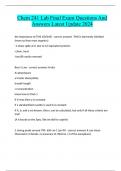
-
Chem 241 Lab Final Exam Questions And Answers Latest Update 2024
- Exam (elaborations) • 10 pages • 2024
-
- $14.49
- + learn more
the importance of TMS (CH3)4Si - correct answers -TMS is extremely shielded (more so than most organics) -1 sharp spike at 0, due to 12 equivalent protons -chem. Inert -low BP, easily removed Beer's Law - correct answers A=abc A=absorbance a=molar absorptivity b=path length c=concentration know how to find c= if λ=max then a is constant if a standardized cuvette is used b is constant if A, b, and a are known, then c can be calculated, but only if all those criteria are met! (A ...
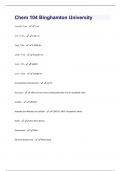
-
Chem 104 Binghamton University Questions With 100% Correct Answers.
- Exam (elaborations) • 12 pages • 2024
- Available in package deal
-
- $7.99
- + learn more
1 cm^3= ? mL - 1 mL 1 in = ? cm - 2.54 cm 1 kg= ? lbs - 2.2046 lbs 1 km = ? mi - 0.62137 mi 1 mi = ? ft - 5280 ft 1 mi = ? km - 1.6093 km Accerleration Derived Unit - m/s^2 Accuracy - refers to how close a measured value is to an accepted value acetate - C2H3O2- Acetates and Nitrates are soluble - C2H3O2-,NO3- Exceptions: None Acids - proton (H+) donors Ammonium - NH4+ Amount SI Base Unit - Mole (mol)Anions - negatively charged ions (gain e-)(nonmetals) Area Derived Unit - m^2 Avag...
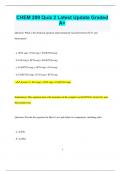
-
CHEM 209 Quiz 2 Latest Update Graded A+
- Exam (elaborations) • 8 pages • 2024
- Available in package deal
-
- $9.99
- + learn more
CHEM 209 Quiz 2 Latest Update Graded A+ Question: What is the chemical equation representing the reaction between Fe3+ and thiocyanate? - a. SCN-(aq) + Fe3+(aq) = Fe(SCN)2+(aq) - b. Fe3+(aq) + SCN-(aq) = Fe(SCN)2+(aq) - c. Fe(SCN)2+(aq) = SCN-(aq) + Fe3+(aq) - d. Fe(SCN)2+(aq) = Fe3+(aq) + SCN-(aq) - Answer: b. Fe3+(aq) + SCN-(aq) = Fe(SCN)2+(aq) Explanation: This equation shows the formation of the complex ion Fe(SCN)2+ from Fe3+ and thiocyanate ions. Question: Provide the...
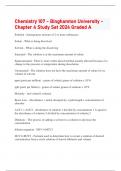
-
Chemistry 107 - Binghamton University - Chapter 4 Study Set 2024 Graded A
- Exam (elaborations) • 4 pages • 2024
-
- $11.99
- + learn more
Solution - homogenous mixture of 2 or more substances Solute - What is being dissolved Solvent - What is doing the dissolving Saturated - The solution is at the maximum amount of solute Supersaturated - There is more solute dissolved than usually allowed because of a change in the pressure or temperature during dissolution Unsaturated - The solution does not have the maximum amount of solute for its volume of solvent ppm (parts per million) - grams of solute/ grams of solution ...
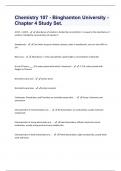
-
Chemistry 107 - Binghamton University - Chapter 4 Study Set Questions & Answers Already Graded A+
- Exam (elaborations) • 5 pages • 2024
- Available in package deal
-
- $7.99
- + learn more
A1/C1 = A2/C2 - absorbance of solution 1 divided by concentration 1 is equal to the absorbance of solution 2 divided by concentration of solution 2 Amphiprotic - Can either accept or donate a proton, water is amphiprotic, can turn into H30+ or OHBeers Law - Absorbance = molar absorptivity x path length x concentration of absorber Br and Cl have a ___ O.N unless paired with which 2 elements? - -1 O.N, unless paired with Oxygen or Fluorine Bronsted-Lowry acid - proton donor Bronsted-Lowry b...
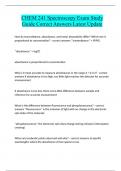
-
CHEM 241 Spectroscopy Exam Study Guide Correct Answers Latest Update
- Exam (elaborations) • 5 pages • 2024
-
- $13.49
- + learn more
How do transmittance, absorbance, and molar absorptivity differ? Which one is proportional to concentration? - correct answers *transmittance* = (P/P0) *absorbance* = log(T) absorbance is proportional to concentration Why is it most accurate to measure absorbances in the range A = 0.3-2? - correct answers If absorbance is too high, too little light reaches the detector for accurate measurement If absorbance is too low, there is too little difference between sample and reference for a...
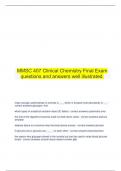
-
MMSC 407 Final Exam questions and answers well illustrated.
- Exam (elaborations) • 20 pages • 2024
-
- $11.49
- + learn more
MMSC 407 Final Exam questions and answers well illustrated. light - correct energy source that can be characterized in terms of wavelength, amplitude and frequency -the visible spectrum wavelength - correct distance between waves amplitude - correct height of a wave frequency - correct many waves pass in one second (related to speed) high energy waves - correct frequency, very short and compact wavelengths -e.g. violet low energy waves - correct frequency, lon...

That summary you just bought made someone very happy. Also get paid weekly? Sell your study resources on Stuvia! Discover all about earning on Stuvia


